생후 1개월~6세 영유아들의 발육 이정표 Developmental milestone of 0~6-year-old children
생후 1개월~6세 영유아들의 발육 이정표 Developmental milestone of 0~6-year-old children
- 각 유아들의 성장과 발육의 속도와 이정표는 그 유아들이 사는 나라, 지방, 문화, 사회, 유전, 체질 등 여러 조건에 따라 정상적으로 다소 차이가 날 수 있다.
- 여기에 있는 유아 발육의 이정표는 미국 유아들의 발육에 바탕을 두고 만든 덴버 발육 스크린 테스트(Dever Development Screening Test)와 소아청소년 성장 발육(Growth and Development of Children, George H. Lowrey, M.D. 8th. Edition) 등 참고서 정보에서 얻은 자료로 만든 것이다.
- 유아들의 나이에 따른 개인성 발육과 사회성 발육, 미세 운동과 전체 운동, 언어 발육의 정도의 이정표를 알아보았다.
- 가로( ) 내 표시된 %는 동년배 남녀 유아들 100명 중 각 발육 항에 해당되는 발육의 정도만큼 발육된 아이들의 수의 %이다.
- 유아 자녀의 발육이 여기에 있는 발육 이정표와 상당히 차이 나면 단골 소아청소년과 의사와 상담하는 것이 적절하다. 참고로 여기서 발육은 발달의 동의이다.
| 생후 1개월 영아들의 발육 이정표 |
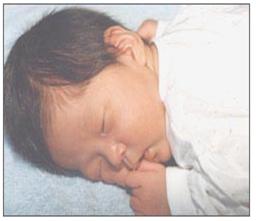
사진 6-1. 신생아들이나 영아들은 엎드려서 재우지 말고 등을 바닥에 대어 재운다.
Copyright ⓒ 2012 John Sangwon Lee, MD., FAAP
- 얼굴을 쳐다볼 수 있다(90%).
- 웃으면서 반응할 수 있다(50~70%).
- 양쪽 팔다리를 동등하게 움직일 수 있다(80%).
- 장난감 실 뭉치를 얼굴 위 한쪽에서 다른 쪽으로 천천히 움직일 때 90도까지 정중선을 따라 볼 수 있다(45%).
- 작은 종소리에 반응할 수 있다(80%).
- 우는 소리 이외 아기소리를 낼 수 있다(85%).
- 엎드려 누워있는 상태에서 머리를 조금 위로 들어 올릴 수 있다(90%).
- 엎드려 누워있는 상태에서 머리를 45도 정도 위로 들어 올릴 수 있다(50%).
- 아기를 보고 웃으면 아기도 웃어 반응할 수 있다(90%).
- 자발적으로 먼저 웃을 수 있다(40%).
- 양쪽 팔다리를 동등하게 움직일 수 있다(90%).
- 장난감 실 뭉치를 얼굴 위에서 한쪽 끝에서 얼굴의 다른 쪽 끝으로 천천히 움직일 때 90도까지 정중선을 따라 볼 수 있다(85%).
- 한쪽 손으로 다른 쪽 손을 잡을 수 있다(50%).
- 소리 내어 웃을 수 있다(50%).
- 큰 소리를 내어 울 수 있다(50%).
- 엎드려 누워있는 상태에서 45도 정도 머리를 들어 올릴 수 있다(75%).
- 엎드려 누워있는 상태에서 90도 정도 머리를 위쪽으로 들어 올릴 수 있다(45%).
- 엎드려 누워있는 상태에서 두 팔로 몸통을 받치면 가슴을 위쪽으로 들어 올릴 수 있다(25%).
- 두 팔을 붙들고 끌어 앉히면 고개를 세울 수 있다(30%).
- 뒤집을 수 있다(25%).
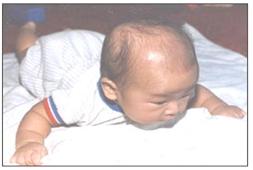
사진 6-2. 2~3개월 된 영아들은 배를 대고 엎드린 자세에서 머리를 위로 들어 올릴 수 있다.
Copyright ⓒ 2012 John Sangwon Lee, MD., FAAP
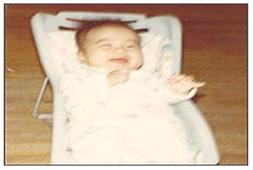
사진 6-3. 2개월 영아는 엄마가 웃으면 따라 웃을 수 있다.
Copyright ⓒ 2012 John Sangwon Lee, MD., FAAP
| 생후 3개월 영아들의 발육 이정표 |
- 자발적으로 먼저 웃을 수 있다(75%).
- 달랑이 장난감을 손으로 쥘 수 있다(40%).
- 건포도를 쳐다볼 수 있다(40%).
- 물체를 잡으려한다(30%).
- 장난감 실 뭉치를 얼굴 위 한쪽 끝에서 얼굴의 다른 쪽 끝으로 천천히 움직일 때 180도까지 정중선을 따라 볼 수 있다(60%).
- 자신이 양손을 서로 잡을 수 있다(75%).
- 자발적으로 소리 내서 웃을 수 있다(85%).
- 자발적으로 큰 소리를 내어 울 수 있다(75%).
- 몸통을 붙들고 세우면 다리에 힘을 주고 설 수 있다(25%).
- 엎드려 누워있을 때 머리를 90도 위쪽으로 들어 올릴 수 있다(85%).
- 엎드려 누어있을 때 두 팔로 몸통을 받치고 앞가슴을 위로 들어 올릴 수 있다(50%).
- 등을 대고 누워있는 아기의 두 손을 잡아 일으켜 앉히면 머리가 축 쳐지지 않고 머리를 곧게 들어 올릴 수 있다(45%)
- 앉을 때 고개를 꼿꼿이 세울 수 있다(50%).
- 뒤집을 수 있다(45%).
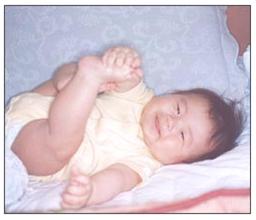
사진 6-4.엄마를 보고 방긋 웃는다.
Copyright ⓒ 2012 John Sangwon Lee, MD., FAAP
| 생후 4개월 영아들의 발육 이정표 |
- 자발적으로 먼저 웃을 수 있다(82%).
- 달랑이 장난감을 쥘 수 있다(80%).
- 건포도를 쳐다볼 수 있다(70%).
- 물체를 잡으려 한다(60%).
- 장난감 실 뭉치를 얼굴 위 한쪽 끝에서 얼굴 위 다른 쪽 끝으로 천천히 움직일 때 180도까지 정중선을 따라 볼 수 있다(88%).
- 자발적으로 소리로 크게 내 울 수 있다(80%).
- 등을 대고 누워있는 아기의 양손을 잡아 일으켜 앉히면 머리가 축 쳐지지 않고 곧게 들어 올릴 수 있다(45%)
- 양 허리를 붙들어 세우면 다리에 힘을 주고 설 수 있다(40%).
- 앉혔을 때 고개를 꼿꼿이 세울 수 있다(85%).
- 엎드려 누어있을 때 두 팔로 받치고 앞가슴을 위로 들어 올릴 수 있다(85%).
- 뒤집힐 수 있다(85%).
- 소리 나는 쪽으로 머리를 돌릴 수 있다(28%).

사진 6-5.4개월 영아가 잡으려고 한다.
Copyright ⓒ 2012 John Sangwon Lee, MD, FAAP
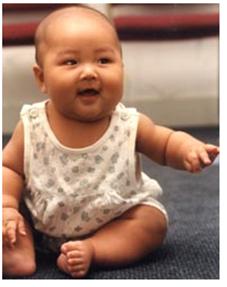
사진 6-6.생후 4 개월에 혼자 앉는 아기도 있다.
Copyright ⓒ 2012 John Sangwon Lee, MD., FAAP
| 생후 5개월 영아들의 발육 이정표 |
- 스스로 먼저 자발적으로 웃을 수 있다(90%).
- 자신이 손으로 크래커를 잡고 먹을 수 있다(40%).
- 건포도를 쳐다볼 수 있다(90%).
- 물체를 잡으려한다(85%).
- 손에 있는 장난감을 뺏으면 놓치지 않으려고 저항할 수 있다(40%).
- 떨어져 있는 장난감을 잡으려한다(28%).
- 장난감 실 뭉치가 없어진 방향을 보고 어디로 갔는지 찾으려고 한다(38%).
- 장난감 실 뭉치를 아기가 보는데서 떨어뜨렸을 때 그 실 뭉치를 찾으려고 한다(30%).
- 한 손에 쥔 정육면체 장난감 블록을 다른 손으로 옮길 수 있다(30%).
- 건포도를 손으로 움켜잡을 수 한다(25%).
- 소리 나는 쪽으로 머리를 돌릴 수 있다(45%).
- 양 허리를 양쪽 손으로 잡고 세우면 다리에 힘을 주고 설 수 있다(70%).
- 누워있는 아기를 잡아 일으켜 앉히면 머리가 축 쳐지지 않고 곧게 들어 올릴 수 있다(45%).
- 앉혔을 때 고개를 꼿꼿이 세울 수 있다(75%).
- 붙들지 않아도 저 혼자 앉을 수 있다(28%).
- 붙들고 설 수 있다(25%).
| 생후 6개월 영아들의 발육 이정표 |
- 낯선 사람을 보면 처음엔 수줍어 할 수 있다(30%).
- 자신이 크래커를 손으로 잡고 먹을 수 있다(70%).
- 손으로 잡고 있는 장난감을 뺏으려 하면 저항할 수 있다(70%).
- 떨어져 있는 장난감을 잡으려한다(60%).
- 까꿍 놀이를 할 수 있다(30%).
- 장난감 실 뭉치를 아기가 보는데서 떨어트렸을 때 그 실 뭉치를 찾으려고 할 수 있다(68%).
- 실 뭉치가 없어진 방향을 보고 어디로 갔는지 찾으려고 할 수 있다(60%)
- 두 개의 장난감 정육면체 블록을 손으로 잡고 놀 수 있다(50%).
- 손으로 건포도를 움켜잡을 수 있다(70%).
- 한쪽 손에 쥔 정육면체 장난감 블록을 다른 손에 옮길 수 있다(60%).
- “마마” 또는 “다다” 등 의미가 확실치 않은 애기 말을 할 수 있다(40%).
- 소리 나는 쪽으로 머리를 돌릴 수 있다(58%).
- 말소리를 아기말로 흉내 낼 수 있다(30%).
- 양 허리로 붙들고 세우면 다리에 힘을 주고 설 수 있다(80%).
- 앉힐 때 고개를 꼿꼿이 세울 수 있다(85%).
- 붙들지 않아도 혼자 앉을 수 있다(68%).
- 가구를 붙들고 설 수 있다(58%).
- 자신이 가구를 붙잡고 일어설 수 있다(25%).
- 혼자 앉을 수 있다(25%).
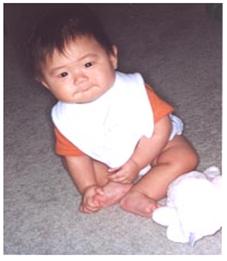
사진 6-7.6개월 된 아기
Copyright ⓒ 2012 John Sangwon Lee, MD., FAAP
| 생후 7개월 영아들의 발육 이정표 |
- 낯선 사람을 보면 처음엔 수줍어할 수 있다(35%).
- 짝짜꿍을 할 수 있다(25%).
- 자신이 크래커 과자를 먹을 수 있다(80%).
- 손에 있는 장난감을 뺏으면 저항할 수 있다(80%).
- 멀리 있는 장난감을 잡으려 한다(75%).
- 까꿍 놀이를 할 수 있다(70%).
- 실 뭉치가 없어진 방향을 보고 어디로 갔는지 찾으려고 할 수 있다(75%).
- 장난감 정육면체 블록 두 개를 손으로 잡고 놀 수 있다(75%).
- 장난감 정육면체 블록 두 개를 양손으로 잡고 서로 부딪치면서 놀 수 있다(25%).
- 건포도를 손으로 움켜잡을 수 있다(80%).
- 엄지손가락과 다른 손가락으로 작은 것을 집을 수 있다(25%).
- 한쪽 손에 쥔 정육면체 장난감 블록을 다른 손으로 옮길 수 있다(85%).
- “마마” 또는 “다다” 등 의미가 확실치 않은 말을 할 수 있다(60%).
- 소리 나는 쪽으로 머리를 돌릴 수 있다(70%).
- 말소리를 아기말로 흉내 낼 수 있다(50%).
- 양 허리를 양손으로 붙들고 세우면 다리에 힘을 주고 설 수 있다(83%).
- 붙들지 않아도 앉을 수 있다(80%).
- 붙들고 설 수 있다(65%).
- 자신이 가구를 붙잡고 일어설 수 있다(45%).
- 혼자 앉을 수 있다(40%).
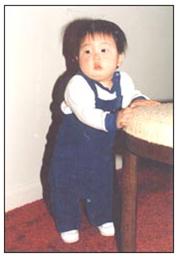
사진 6-8.사랑
Copyright ⓒ 2012 John Sangwon Lee, MD., FAAP
| 생후 8개월 영아들의 발육 이정표 |
- 낯선 사람을 보면 처음엔 수줍어할 수 있다(40%).
- 짝짜꿍을 할 수 있다(35%).
- 자신이 영아 크래커 과자를 손으로 붙들고 먹을 수 있다(92%).
- 손에 있는 장난감을 뺏으면 안 뺏기려고 저항 할 수 있다(85%).
- 까꿍 놀이를 할 수 있다(80%).
- 실 뭉치가 없어진 방향을 보고 어디로 갔는지 찾으려고 할 수 있다(85%).
- 장난감 정육면체 블록 두 개를 양손으로 잡고 서로 부딪치면서 놀 수 있다(40%).
- 엄지손가락과 다른 손가락을 이용해 작은 것을 집을 수 있다(40%).
- “마마” 또는 “다다” 등 의미가 확실치 않은 애기 말을 할 수 있다(70%).
- 소리 나는 쪽으로 머리를 돌릴 수 있다(85%).
- 가구를 붙들고 혼자 걸을 수 있다(30%).
- 자신이 가구를 붙잡고 설 수 있다(70%).
- 자신이 가구 등을 붙잡고 일어설 수 있다(60%).
- 혼자 앉을 수 있다(60%).
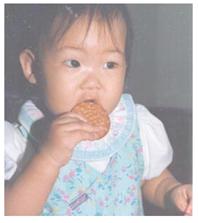
사진 6-9.생후 8개월 영아가 이유식 아기과자를 먹는다.
Copyright ⓒ 2012 John Sangwon Lee, MD., FAAP
| 생후 9개월 영아들의 발육 이정표 |
- 낯선 사람을 보면 처음엔 수줍어 할 수 있다(45%).
- 짝짜꿍을 할 수 있다(50%).
- 손에 가지고 있는 장난감을 뺏으면 안 주려고 저항 할 수 있다(88%).
- 까꿍 놀이를 할 수 있다(88%).
- 장난감 정육면체 블록 두개를 양손으로 잡고 서로 부딪치면서 놀 수 있다(70%).
- 엄지손가락과 다른 손가락으로 작은 물체를 집을 수 있다(75%).
- “마마” 또는 “다다” 등 의미가 확실치 않은 아기 말을 할 수 있다(80%).
- 의미 있게 “마마” 또는 “다다” 소리를 내어 아기 말을 할 수 있다(25%).
- 말소리를 아기말로 흉내 낼 수 있다(75%).
- 잠시 동안 혼자 설 수 있다(25%).
- 가구를 붙들고 혼자 걸을 수 있다(48%).
- 자신이 가구를 붙잡고 설 수 있다(80%).
- 자신이 가구를 붙잡고 일어설 수 있다(70%).
- 혼자 앉을 수 있다(70%).
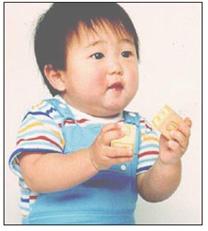
사진 6-10. 생후 9개월 영아가 두 개의 장난감 정육면체 블록을 양손으로 잡고 서로 부딪치면서 놀 수 있다.
Copyright ⓒ 2012 John Sangwon Lee, MD., FAAP
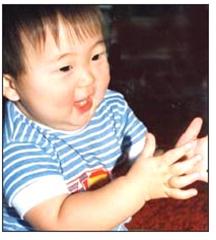
사진 6-11. 생후 9개월 영아가 짝짝꿍 놀이를 할 수 있다.
Copyright ⓒ 2012 John Sangwon Lee, MD., FAAP
| 생후 10개월 영아들의 발육 이정표 |
- 낯선 사람을 보면 처음엔 수줍어 할 수 있다(90%).
- 짝짜꿍을 할 수 있다(78%).
- 공놀이를 할 수 있다(30%).
- 손에 가지고 있는 장난감을 뺏으면 안 주려고 저항할 수 있다(90%).
- 자신이 이유식 연습용 컵으로 음료수를 마실 수 있다(25%)
- 두 개의 장난감 정육면체 블록을 양쪽 손으로 잡고 서로 부딪치면서 놀 수 있다(80%).
- 엄지손가락과 다른 손가락으로 작은 물체를 집을 수 있다(85%).
- 엄지손가락과 다른 손가락으로 건포도를 잘 집을 수 있다(40%).
- “마마” 또는 “다다” 등 의미가 확실치 않은 말을 할 수 있다(85%).
- 의미 있게 “마마” 또는 “다다” 소리를 내어 말을 할 수 있다(50%).
- 말소리를 아기말로 흉내 낼 수 있다(80%).
- 잠시 동안 혼자 설 수 있다(57%).
- 가구를 붙들고 혼자서 걸을 수 있다(70%).
- 혼자서 잘 설 수 있다(25%).
- 자신이 가구를 붙잡고 설 수 있다(90%).
- 자신이 가구를 붙잡고 일어설 수 있다(90%).
- 혼자 앉을 수 있다(80%).

사진 6-12. 10개월 영아가 공을 가지고 놀 수 있다.
Copyright ⓒ 2012 John Sangwon Lee, MD., FAAP
| 생후 11개월 영아들의 발육 이정표 |
- 짝짜꿍 놀이를 할 수 있다(80%).
- 갖고 싶고 원하는 것을 가리킬 수 있다(30%).
- 공놀이를 할 수 있다(40%).
- 자신이 이유식 연습용 컵으로 음료수를 마실 수 있다(40%).
- 장난감 정육면체 블록 두개를 양쪽 손으로 잡고 서로 부딪치면서 놀 수 있다(85%).
- 엄지손가락과 다른 손가락으로 건포도를 잘 집을 수 있다(60%)
- “마마” 또는 “다다” 등 의미가 확실치 않은 아기 말을 할 수 있다(90%)
- 의미 있게 “마마” 또는 “다다” 소리를 내어 아기 말을 할 수 있다(65%).
- 말소리를 아기말로 흉내 낼 수 있다(90%).
- 잠시 동안 혼자 설 수 있다(60%).
- 가구를 붙들고 혼자 걸을 수 있다(80%).
- 혼자서 잘 설 수 있다(40%).
- 허리를 꾸부리고 무엇을 찾고 집을 수 있다(30%).
- 혼자 앉을 수 있다(90%).

사진 6-13.가구를 붙들고 걷기도 한다.
Copyright ⓒ 2012 John Sangwon Lee, MD, FAAP
| 생후 12개월 영아들의 발육 이정표 |
- 짝짜꿍 놀이를 할 수 있다(85%).
- 공놀이를 할 수 있다(60%).
- 갖고 싶은 것을 가리킬 수 있다(45%).
- 이유식 연습용 컵으로 액체 이유식을 마실 수 있다(55%).
- 연필로 종이에 아무렇게나 그적거릴 수 있다(27%).
- 장난감 정육면체 블록 두개를 양쪽 손으로 잡고 서로 부딪치면서 놀 수 있다(88%).
- 엄지손가락과 다른 손가락으로 건포도를 잘 집을 수 있다(75%).
- “마마” 또는 “다다” 이외 세 단어를 써서 말을 할 수 있다(27%).
- 의미 있게 “마마” 또는 “다다” 소리를 내어 말을 할 수 있다(80%).
- 잠시 동안 혼자서 설 수 있다(80%).
- 가구를 붙들고 혼자 걸을 수 있다(85%).
- 혼자서 잘 설 수 있다(60%).
- 허리를 꾸부리고 무엇을 찾고 집을 수 있다(65%).
- 혼자서 잘 걸을 수 있다(50%).
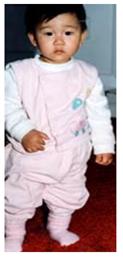
사진 6-14. 12개월 영아는 혼자서 잘 걸을 수 있다.
Copyright ⓒ 2012 John Sangwon Lee, MD., FAAP
| 생후 13개월 유아들의 발육 이정표 |
- 흉내 내어 집안일을 할 수 있다(35%).
- 짝짜꿍 놀이를 할 수 있다(90%).
- 공놀이를 할 수 있다(70%).
- 갖고 싶은 것을 가리킬 수 있다(68%).
- 자신이 컵으로 음료수를 마실 수 있다(65%).
- 연필로 종이에 아무렇게나 그적거릴 수 있다(45%).
- 장난감 정육면체 블록 두 개로 탑 모양을 만들 수 있다(30%).
- 엄지손가락과 다른 손가락으로 건포도를 잘 집을 수 있다(80%).
- 병 속에 든 건포도를 흉내 내 쏟을 수 있다(40%).
- “마마” 또는 “다다” 이외 세 단어를 써서 말할 수 있다(55%).
- 의미 있게 “마마” 또는 “다다” 소리를 내어 말할 수 있다(85%).
- 잠시 동안 혼자서 설 수 있다(90%).
- 혼자서 잘 설 수 있다(70%).
- 허리를 꾸부리고 무엇을 찾고 집을 수 있다(70%).
- 혼자서 잘 걸을 수 있다(65%).
- 뒤로 걸을 수 있다(35%).
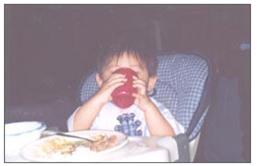
사진 6-15.이 나이 유아들의 대분은 컵으로 마실 수 있다.
Copyright ⓒ 2012 John Sangwon Lee, MD., FAAP
| 생후 14개월 유아들의 발육 이정표 |
- 집안일을 흉내 내 할 수 있다(55%).
- 자신이 거의 흘리지 않고 수저로 먹을 수 있다(40%).
- 공놀이를 할 수 있다(80%).
- 갖고 싶은 것을 가리킬 수 있다(85%).
- 컵으로 음료수를 마실 수 있다(72%).
- 혼자서 옷을 벗을 수 있다(30%).
- 종이에 아무렇게나 연필로 그적거릴 수 있다(60%).
- 장난감 정육면체 블록 두개로 탑 모양을 만들 수 있다(50%).
- 엄지손가락과 다른 손가락으로 건포도를 잘 집을 수 있다(85%).
- 병 속에 든 건포도를 흉내 내 쏟을 수 있다(60%).
- 병 속에 든 건포도를 자신이 쏟을 수 있다(40%).
- “마마” 또는 “다다” 이외 세 단어를 써서 말할 수 있다(70%).
- 두 다른 단어를 써서 말할 수 있다(25%).
- 신체의 한 부위의 이름을 옳게 말할 수 있다(25%).
- 허리를 꾸부리고 무엇을 찾고 집을 수 있다(85%).
- 혼자서 잘 걸을 수 있다(85%).
- 뒤로 걸을 수 있다(45%).
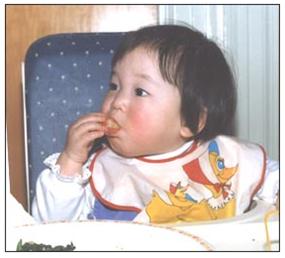
사진 6-16.흘리지 않고 음식물을 잘 먹을 수 있다.
Copyright ⓒ 2012 John Sangwon Lee, MD., FAAP
| 생후 15개월 유아들의 발육 이정표 |
- 집안일을 흉내 내 할 수 있다(63%).
- 거의 흘리지 않고 숟가락으로 음식물을 먹을 수 있다(55%).
- 간단한 집안일을 도울 수 있다(25%).
- 공놀이를 할 수 있다(83%).
- 자신이 음료수를 컵으로 마실 수 있다(80%).
- 혼자서 옷을 벗을 수 있다(40%).
- 아무렇게나 연필로 그적거릴 수 있다(70%).
- 장난감 정육면체 블록 두 개로 탑 모양을 만들 수 있다(60%).
- 병 속 건포도를 흉내 내 쏟을 수 있다(68%).
- 병 속 건포도를 자신이 쏟을 수 있다(50%).
- “마마” 또는 “다다” 이외 세 단어를 써서 말할 수 있다(75%).
- 그 외 다른 두 단어를 써서 말할 수 있다(30%).
- 신체의 한 부위의 이름을 말할 수 있다(30%).
- “장난감 정육면체 블록을 엄마에게 주세요.”, “그것을 테이블 위에 놓으세요.”, “그것을 방바닥에 놓으세요.” 라고 세 가지 요구사항을 한꺼번에 할 때 적어도 두 가지 요구사항을 따라 수행할 수 있다(25%).
- 공을 앞으로 찰 수 있다(25%).
- 공을 머리 위로 던질 수 있다(25%).
- 뒤로 걸을 수 있다(55%).
- 계단을 걸어 올라갈 수 있다(30%).
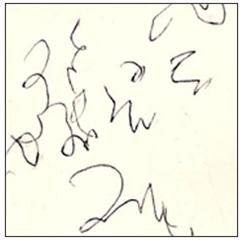
사진 6-17. 15개월 유아는 연필로 그적거릴 수 있다.
Copyright ⓒ 2012 John Sangwon Lee, MD., FAAP
| 생후 16개월 유아들의 발육 이정표 |
- 집안일을 흉내 내 할 수 있다(70%).
- 거의 흘리지 않고 숟가락으로 먹을 수 있다(63%).
- 혼자서 공놀이를 할 수 있다(90%).
- 간단한 집안일을 도울 수 있다(30%).
- 자신이 음료수를 컵으로 마실 수 있다(85%).
- 혼자서 옷을 벗을 수 있다(55%).
- 아무렇게나 연필로 그적거릴 수 있다(74%).
- 장난감 정육면체 블록 두 개로 탑 모양을 만들 수 있다(70%).
- 장난감 정육면체 블록 4개로 탑 모양을 만들 수 있다(35%).
- 병 속 건포도를 흉내 내 쏟을 수 있다(70%).
- 병 속 건포도를 자신이 쏟을 수 있다(55%).
- “마마” 또는 “다다” 이외 세 단어를 써서 말할 수 있다(80%).
- 그 외 다른 두 단어를 써서 말할 수 있다(35%).
- 신체의 한 부위의 이름을 말한 수 있다(38%).
- “장난감 정육면체 블록을 엄마에게 주세요.”, “그것을 테이블 위에 놓으세요.”, “그것을 방바닥에 놓으세요.” 라고 세 가지 요구사항을 한 번에 할 때 적어도 두 가지 요구사항을 따라 수행할 수 있다(30%).
- 공을 앞으로 찰 수 있다(30%).
- 공을 머리 위로 던질 수 있다(30%).
- 뒤로 걸을 수 있다(68%).
- 계단을 걸어 올라갈 수 있다(40%).
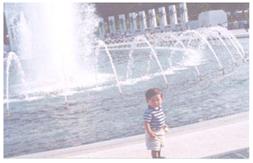
사진 6-18. 이 시기 유아들은 구경 가기를 좋아한다.
Copyright ⓒ 2012 John Sangwon Lee, MD, FAAP
| 생후 17개월 유아들의 발육 이정표 |
- 집안일을 흉내 내 할 수 있다(80%).
- 거의 흘리지 않고 숟가락으로 혼자서 먹을 수 있다(70%).
- 간단한 집안일을 도울 수 있다(35%).
- 혼자서 옷을 벗을 수 있다(60%).
- 연필로 종이에 아무렇게나 그적거릴 수 있다(76%).
- 장난감 정육면체 블록 두개로 탑 모양을 만들 수 있다(75%).
- 장난감 정육면체 블록 4개로 탑 모양을 만들 수 있다(40%).
- 병 속 건포도를 흉내 내 쏟을 수 있다(73%).
- 병 속 건포도를 자신이 쏟을 수 있다(59%).
- 마마 다다 이외에 세 단어를 써서 말할 수 있다(82%).
- 그 외 다른 두 단어를 써서 말할 수 있다(38%).
- 신체의 한 부위의 이름을 말할 수 있다(42%).
- 고양이 새 말 개 사람의 그림 중 무엇이라고 적어도 하나를 옳게 말할 수 있다(30%).
- “장난감 정육면체 블록을 엄마에게 주세요.”, “그것을 테이블 위에 놓으세요.”, “그것을 방바닥에 놓으세요.” 라고 세 가지 요구사항을 한 번에 할 때 적어도 두 가지 요구사항을 따라 수행 할 수 있다(38%).
- 공을 앞으로 찰 수 있다(32%).
- 공을 머리 위로 던질 수 있다(32%).
- 뒤로 걸을 수 있다(70%).
- 계단을 걸어 올라갈 수 있다(50%).
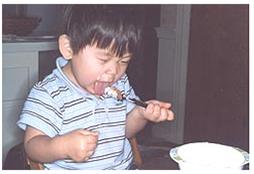
사진 6-19.흘리지 않고 숟가락으로 잘 먹는 유아들도 많다.
Copyright ⓒ 2012 John Sangwon Lee, MD., FAAP
| 생후 18개월 유아들의 발육 이정표 |
- 집안일을 흉내 내 할 수 있다(85%).
- 혼자서 거의 흘리지 않고 숟가락으로 먹을 수 있다(75%).
- 간단한 집안일을 도울 수 있다(40%).
- 혼자서 옷을 벗을 수 있다(70%).
- 종이에 아무렇게나 연필로 그적거릴 수 있다(78%).
- 장난감 정육면체 블록 두개로 탑 모양을 만들 수 있다(80%).
- 장난감 정육면체 블록 4개로 탑 모양을 만들 수 있다(55%).
- 병 속에 든 건포도를 흉내 내 쏟을 수 있다(76%).
- 병 속에 든 건포도를 자신이 쏟을 수 있다(62%).
- “마마” 또는 “다다” 이외 세 단어를 써서 말할 수 있다(86%).
- 그 외 다른 두 단어를 써서 말할 수 있다(40%).
- 신체의 한 부위의 이름을 옳게 말할 수 있다(55%).
- 고양이 새 말 개 사람의 그림 중 무엇이라고 적어도 하나를 옳게 말할 수 있다(35%).
- “장난감 정육면체 블록을 엄마에게 주세요.”, “그것을 테이블 위에 놓으세요.”, “그것을 방바닥에 놓으세요.” 라고 세 가지 요구사항을 한 번에 할 때 적어도 두 가지 요구사항을 따라 수행 할 수 있다(42%).
- 공을 앞으로 찰 수 있다(40%).
- 공을 머리 위로 던질 수 있다(40%).
- 뒤로 걸을 수 있다(72%).
- 계단을 걸어 올라갈 수 있다(55%).
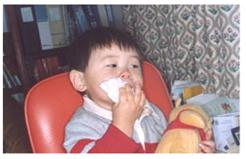
사진 6-20. 18개월 유아는 혼자서 손도 닦고 얼굴도 어느 정도 닦을 수 있다.
Copyright ⓒ 2012 John Sangwon Lee, MD., FAAP
| 생후 19개월 유아들의 발육 이정표 |
- 집안일을 흉내 낼 수 있다(88%).
- 거의 흘리지 않고 음식물을 숟가락으로 먹을 수 있다(80%).
- 혼자서 손을 씻고 수건으로 물기를 닦을 수 있다(25%).
- 간단한 집안일을 도울 수 있다(50%).
- 혼자서 옷을 벗을 수 있다(75%).
- 종이에 아무렇게나 연필로 그적거릴 수 있다(80%).
- 장난감 정육면체 블록 두개로 탑 모양을 만들 수 있다(88%).
- 장난감 정육면체 블록 4개로 탑 모양을 만들 수 있다(70%).
- 수직선을 종이에 30도 경사로 흉내 내 그릴 수 있다(25%).
- 병 속에 든 건포도를 자신이 쏟을 수 있다(64%).
- 병 속에 든 건포도를 흉내 내 쏟을 수 있다(79%).
- “마마” 또는 “다다” 이외 세 단어를 써서 말할 수 있다(87%).
- 그 외 다른 두 단어를 써서 말할 수 있다(48%).
- 신체의 한 부위의 이름을 옳게 말할 수 있다(62%).
- 고양이 새 말 개 사람 그림들 중 무엇이라고 적어도 하나를 맞게 말할 수 있다(40%).
- “장난감 나무토막을 엄마에게 주세요.”, “그것을 테이블 위에 놓으세요.”, “그것을 방바닥에 놓으세요.” 라고 세 가지 요구사항을 한 번에 할 때 적어도 두 가지 요구사항을 따라 수행할 수 있다(48%).
- 공을 앞으로 찰 수 있다(45%).
- 공을 머리 위로 던질 수 있다(48%).
- 뒤로 걸을 수 있다(80%).
- 혼자서 계단을 걸어 올라갈 수 있다(60%).
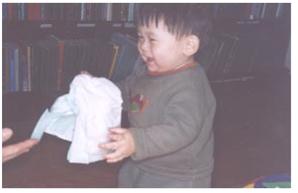
사진 6-21.간단한 심부름을 할 수 있다.
Copyright ⓒ 2012 John Sangwon Lee, MD., FAAP
| 생후 20개월 유아들의 발육 이정표 |
- 혼자 옷을 입을 수 있다(25%).
- 거의 흘리지 않고 음식물을 숟가락으로 먹을 수 있다(83%).
- 혼자서 손을 씻고 수건으로 물기를 닦을 수 있다(30%).
- 간단한 집안일을 도울 수 있다(55%).
- 술래잡기 놀이를 할 수 있다(25%).
- 혼자서 옷을 벗을 수 있다(80%).
- 종이에 아무렇게나 연필로 그적거릴 수 있다(82%).
- 장난감 정육면체 블록 두개로 탑 모양을 만들 수 있다(90%).
- 장난감 정육면체 블록 4개로 탑 모양을 만들 수 있다(73%).
- 수직선을 보고 종이에 30도 이상 더 경사지지 않게 수직선을 흉내 내 그릴 수 있다(30%).
- 병 속에 든 건포도를 자신이 쏟을 수 있다(67%).
- 병 속에 든 건포도를 흉내 내 쏟을 수 있다(83%).
- “마마” 또는 “다다” 이외 세 단어를 써서 말할 수 있다(88%).
- 그 외 두 다른 단어를 써서 말할 수 있다(50%).
- 신체의 한 부위의 이름을 옳게 말할 수 있다(70%).
- 고양이 새 말 개 사람 그림들 중 무엇이라고 적어도 하나를 맞게 말할 수 있다(45%).
- “장난감 나무토막을 엄마에게 주세요.”, “그것을 테이블 위에 놓으세요.”, “그것을 방바닥에 놓으세요.” 라고 세 가지 요구사항을 한 번에 할 때 적어도 두 가지 요구사항을 따라 수행할 수 있다(50%).
- 복수를 써서 말할 수 있다(35%).
- 공을 앞으로 찰 수 있다(50%).
- 공을 머리 위로 던질 수 있다(53%).
- 뒤로 걸을 수 있다(83%).
- 혼자서 계단을 걸어 올라갈 수 있다(70%).
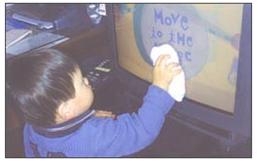
사진 6-22.생후 20개월 유아는 테이블 위 물기를 닦는다.
Copyright ⓒ 2012 John Sangwon Lee, MD., FAAP
| 생후 21개월 유아들의 발육 이정표 |
- 혼자서 옷을 입을 수 있다(30%).
- 거의 흘리지 않고 음식물을 숟가락으로 먹을 수 있다(85%).
- 혼자서 손을 씻고 수건으로 물기를 닦을 수 있다(35%).
- 간단한 집안일을 도울 수 있다(70%).
- 술래잡기 놀이를 할 수 있다(30%).
- 혼자서 옷을 벗을 수 있다(85%).
- 연필로 종이에 아무렇게나 그적거릴 수 있다(84%).
- 장난감 정육면체 블록 4개로 탑 모양을 만들 수 있다(78%).
- 장난감 정육면체 블록 8개로 탑 모양을 만들 수 있다(25%).
- 수직선을 보고 종이에 30도 이상 더 경사지지 않게 수직선을 흉내 내 그릴 수 있다(40%).
- 병 속 건포도를 자신이 쏟을 수 있다(70%).
- 병 속 건포도를 흉내 내 쏟을 수 있다(86%).
- 두 다른 단어를 써서 말할 수 있다(60%).
- 신체의 한 부위의 이름을 옳게 말할 수 있다(75%).
- 고양이 새 말 개 사람 그림들 중 무엇이라고 적어도 하나를 맞게 말할 수 있다(55%).
- “장난감 정육면체 블록을 엄마에게 주세요.”, “그것을 테이블 위에 놓으세요.”, “그것을 방바닥에 놓으세요.” 라고 세 가지 요구사항을 한 번에 할 때 적어도 두 가지 요구사항을 따라 수행할 수 있다(68%).
- 복수를 써서 말할 수 있다(30%).
- 공을 앞으로 찰 수 있다(60%).
- 공을 머리 위로 던질 수 있다(60%).
- 넓이 뛰기를 할 수 있다(25%).
- 뒤로 걸을 수 있다(88%).
- 혼자서 계단을 걸어 올라갈 수 있다(75%).
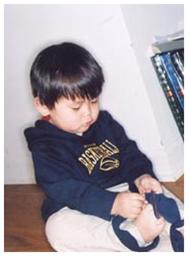
사진 6-23. 생후 21개월 유아는 옷을 벗을 수 있다.
Copyright ⓒ 2012 John Sangwon Lee, MD., FAAP
| 생후 22개월 유아들의 발육 이정표 |
- 혼자서 옷을 입을 수 있다(35%).
- 거의 흘리지 않고 음식물을 숟가락으로 먹을 수 있다(88%).
- 혼자서 손을 씻고 수건으로 물기를 닦을 수 있다(40%).
- 간단한 집안일을 도울 수 있다(80%).
- 술래잡기 놀이를 할 수 있다(35%).
- 연필로 종이에 아무렇게나 그적거릴 수 있다(86%).
- 장난감 정육면체 블록 4개로 탑 모양을 만들 수 있다(80%).
- 장난감 정육면체 블록 8개로 탑 모양을 만들 수 있다(30%).
- 수직선을 보고 종이에 30도 이상 더 경사지지 않게 흉내 내 그릴 수 있다(50%).
- 병 속 건포도를 자신이 쏟을 수 있다(71%).
- 병 속 건포도를 흉내 내 쏟을 수 있다(87%).
- 두 다른 단어를 써서 말할 수 있다(70%).
- 신체의 한 부위의 이름을 옳게 말할 수 있다(80%).
- 고양이 새 말 개 사람 그림들 중 무엇이라고 적어도 하나를 맞게 말할 수 있다(65%).
- “장난감 나무토막을 엄마에게 주세요.”, “그것을 테이블 위에 놓으세요.”, “그것을 방바닥에 놓으세요.” 라고 세 가지 요구사항을 한 번에 할 때 적어도 두 가지 요구사항을 따라 수행할 수 있다(70%).
- 복수를 써서 말할 수 있다(35%).
- 공을 앞으로 찰 수 있다(68%).
- 공을 머리 위로 던질 수 있다(68%).
- 넓이 뛰기를 할 수 있다(30%).
- 세발자전거를 발판 디디고 탈 수 있다(30%).
- 혼자서 계단을 걸어 올라갈 수 있다(88%).
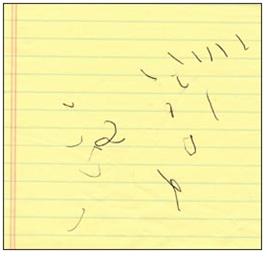
사진 6-24. 생후 22개월 된 유아는 수직선을 이렇게 그릴 수 있다.
Copyright ⓒ 2012 John Sangwon Lee, MD, FAAP
| 생후 23개월 유아들의 발육 이정표 |
- 혼자서 옷을 입을 수 있다(55%).
- 거의 흘리지 않고 음식물을 숟가락으로 먹을 수 있다(98%).
- 혼자서 손을 씻고 수건으로 물기를 닦을 수 있다(50%).
- 간단한 집안일을 도울 수 있다(88%).
- 전보다 엄마로부터 쉽게 떨어져 있을 수 있다(25%).
- 술래잡기 놀이를 할 수 있다(40%).
- 종이에 아무렇게나 연필로 그적거릴 수 있다(88%).
- 장난감 정육면체 블록 4개로 탑 모양을 만들 수 있다(83%).
- 장난감 정육면체 블록 8개로 탑 모양을 만들 수 있다(40%).
- 수직선을 보고 30도 이상 더 경사지지 않게 흉내 내 종이에 그릴 수 있다(60%).
- 병 속 건포도를 자신이 쏟을 수 있다(72%).
- 병 속 건포도를 흉내 내 쏟을 수 있다(88%).
- 두 다른 단어를 써서 말할 수 있다(78%).
- 신체의 한 부위의 이름을 옳게 말할 수 있다(90%).
- 고양이 새 말 개 사람의 그림 중 무엇이라고 적어도 하나를 맞게 말할 수 있다(68%).
- “장난감 나무토막을 엄마에게 주세요.”, “그것을 테이블 위에 놓으세요.”, “그것을 방바닥에 놓으세요.” 라고 세 가지 요구사항을 한 번에 할 때 적어도 두 가지 요구사항을 따라 수행 할 수 있다(78%).
- 복수를 써서 말할 수 있다(38%).
- 공을 앞으로 찰 수 있다(80%).
- 공을 머리 위로 던질 수 있다(75%).
- 한 발을 들고 다른 발로 1초 동안 균형 잡히게 서 있을 수 있다(30%).
- 넓이 뛰기를 할 수 있다(55%).
- 세 발 자전거의 발판을 디디고 탈 수 있다(40%).
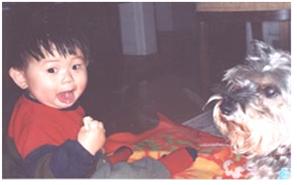
사진 6- 25고양이 새 말 개 사람의 그림 중 적어도 한가지의 그림의 이름에 맞게 말할 수 있다.
Copyright ⓒ 2012 John Sangwon Lee, MD., FAAP
| 생후 24개월 유아들의 발육 이정표 |
- 혼자서 옷을 입을 수 있다(60%).
- 혼자서 손을 씻고 수건으로 물기를 닦을 수 있다(57%).
- 간단한 집안일을 도울 수 있다(90%).
- 엄마로부터 전보다 더 쉽게 떨어져 있을 수 있다(30%).
- 술래잡기 놀이를 할 수 있다(50%).
- 아무렇게나 종이에 연필로 그적거릴 수 있다(89%).
- 장난감 정육면체 블록 4개로 탑 모양을 만들 수 있다(85%).
- 장난감 정육면체 블록 8개로 탑 모양을 만들 수 있다(55%).
- 수직선을 보고 30도 이상 더 경사지지 않게 흉내 내 종이에 그릴 수 있다(70%).
- 병 속 건포도를 자신이 쏟을 수 있다(75%).
- 병 속 건포도를 흉내 내 쏟을 수 있다(90%).
- 두 다른 단어를 써서 말할 수 있다(80%).
- 고양이 새 말 개 사람 그림들 중 무엇이라고 적어도 하나의 그림 이름을 맞게 말할 수 있다(70%).
- “장난감 나무토막을 엄마에게 주세요.”, “그것을 테이블 위에 놓으세요.”, “그것을 방바닥에 놓으세요.” 라고 세 가지 요구사항을 한 번에 할 때 적어도 두 가지 요구사항을 따라 수행할 수 있다(80%).
- 복수를 써서 말할 수 있다(40%).
- 성과 이름을 말할 수 있다(25%).
- 공을 앞으로 찰 수 있다(90%).
- 공을 머리 위로 던질 수 있다(80%).
- 한 발을 들고 다른 발로 적어도 1초 동안 균형 잡히게 서 있을 수 있다(35%).
- 넓이 뛰기를 할 수 있다(60%).
- 세발자전거를 발판 디디고 탈 수 있다(50%).
- 넓게 뛸 수 있다(25%).
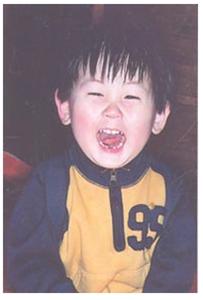
사진 6-26.엄마로부터 쉽게 떨어져 있을 수 있다.
Copyright ⓒ 2012 John Sangwon Lee, MD., FAAP
| 생후 30개월 유아들의 발육 이정표 |
- 혼자서 옷을 입을 수 있다(75%).
- 손을 씻고 수건으로 물기를 닦을 수 있다(75%).
- 옷을 벗으라는 말을 듣고 부모 앞에서 부모의 도움이 없이 옷을 벗을 수 있다(30%).
- 엄마로부터 이전보다 더 쉽게 떨어져 있을 수 있다(35%).
- 술래잡기 놀이를 할 수 있다(60%).
- 동그라미(◯)를 보고 종이에 그릴 수 있다(50%).
- 장난감 정육면체 블록으로 다리 모양을 만들 수 있다(48%).
- 장난감 정육면체 블록 8개로 탑 모양을 만들 수 있다(77%).
- 수직선을 보고 30도 이상 더 경사지지 않게 수직선을 흉내 내 종이에 그릴 수 있다(80%).
- 병 속 건포도를 자신이 쏟을 수 있다(80%).
- 고양이 새 말 개 사람 그림글 중 무엇이라고 적어도 그림 하나를 맞게 말할 수 있다(98%).
- “장난감 나무토막을 엄마에게 주세요.”, “그것을 테이블 위에 놓으세요.”, “그것을 방바닥에 놓으세요.” 라고 세 가지 요구사항을 한 번에 할 때 적어도 두 가지 요구 사항을 따라 수행 할 수 있다(85%).
- 복수를 써서 말할 수 있다(70%).
- 성과 이름을 말할 수 있다(40%).
- 공을 머리 위로 던질 수 있다(88%).
- 한 발을 들고 다른 발로 적어도 1초 동안 균형 잡히게 있을 수 있다(45%).
- 넓이 뛰기를 할 수 있다(73%).
- 세발자전거를 발판 디디고 탈 수 있다(65%).
- 넓게 뛸 수 있다(35%).이렇게 원을 그리는 유아도 있다.
Copyright ⓒ 2012 John Sangwon Lee, MD., FAAP
| 만 3세 유아들의 발육 |
- 스스로 옷을 입을 수 있다(90%).
- 혼자서 단추를 낄 수 있다(50%).
- 혼자서 손을 씻고 수건으로 물기를 닦을 수 있다(95%).
- 말만 듣고 부모 앞에서 부모의 도움 없이 옷을 입을 수 있다(70%).
- 엄마로부터 쉽게 떨어져 있을 수 있다(50%).
- 술래잡기 놀이를 할 수 있다(75%).
- 자기 혼자서 옷을 입을 수 있다(35%).
- 십자(+)를 보고 종이에 그릴 수 있다(28%).
- 동그라미(◯)를 보고 종이에 그릴 수 있다(78%).
- 장난감 정육면체 블록 8로 다리 모양을 만들 수 있다(72%).
- 장난감 정육면체 블록 8개로 탑 모양을 차곡차곡 만들 수 있다(80%).
- 수직선을 보고 30도 이상 더 경사지지 않게 수직선을 흉내 내 종이에 그릴 수 있다(90%).
- 병 속 건포도를 자신이 쏟을 수 있다(90%).
- 길고 짧은 두 직선을 보이고 어떤 선이 더 긴 것인가 3번 물었을 때 3번 다 맞게 답을 하거나 6번 물었을 때 5번 맞게 답할 수 있다(55%).
- 차다, 배고프다, 피로하다, 3단어 중 두 단어의 뜻을 알 수 있다(50%).
- 장난감 정육면체 블록을 책상 위에”, 책상 아래에, 의자 앞에, 의자 뒤에 놓으라고 말을 할 때 그 말에 있는 4가지 전치사 중 적어도 3가지 전치사의 의미를 알 수 있다(40%).
- 4가지 색 중 3가지 색을 알 수 있다(50%).
- 불은 뜨겁고 얼음은?, 엄마는 여자이고 아빠는?, 말은 크고 쥐는? 이라는 반대어를 물으면 답을 할 수 있다(30%).
- 복수를 써서 말할 수 있다(80%).
- 성과 이름을 말할 수 있다(70%).
- 한쪽 발로 균형 잡히게 10초 동안 설 수 있다(25%).
- 한쪽 발로 뛸 수 있다(25%).
- 한 발을 들고 다른 발로 적어도 1초 동안 균형 잡히게 서 있을 수 있다(75%).
- 넓게 뛸 수 있다(75%).
- 한쪽 발로 5초 동안 균형 잡히게 설 수 있다(40%).
| 만 3세 6개월 유아들의 발육 |
- 단추를 혼자 낄 수 있다(70%).
- 말만 듣고 부모 앞에서 옷을 입을 수 있다(90%).
- 엄마로부터 쉽게 떨어져 있을 수 있다(75%).
- 술래잡기 놀이를 할 수 있다(90%).
- 자기 혼자서 옷을 입을 수 있다(45%).
- 십자(+)를 보고 종이에 그릴 수 있다(60%).
- 정사각형을 보여 주고 그리라고 하면 종이에 그릴 수 있다(25%).
- 장난감 정육면체 블록으로 다리 모양을 만들 수 있다(90%).
- 장난감 정육면체 블록 8개로 탑 모양을 만들 수 있다(90%).
- 사람 신체의 3 부분을 그릴 수 있다(30%).
- 길고 짧은 두 직선을 보이고 어떤 선이 더 긴지 3번 물었을 때 3번 옳게 답하거나 6번 물었을 때 5번 옳게 답할 수 있다(75%).
- 차다 배고프다 피로하다 3 단어들 중 두 단어의 뜻을 알 수 있다(75%).
- 장난감 정육면체 블록을 책상 위에, 책상 아래에, 의자 앞에, 의자 뒤에 놓으라는 4가지 전치사를 써서 말을 할 때 4가지 전치사들 중 적어도 3 가지 전치사의 의미를 알 수 있다(78%).
- 4가지 색깔 중 3가지 색깔을 알 수 있다(70%).
- 불은 뜨겁고 얼음은?, 엄마는 여자이고 아빠는?, 말은 크고 쥐는? 이라는 반대어를 물으면 답을 할 수 있다(55%).
- 성과 이름을 말할 수 있다(80%).
- 한쪽 발로 10초 동안 균형 잡히게 설 수 있다(35%).
- 한쪽 발로 뛸 수 있다(50%).
- 한쪽 발가락 앞에 다른 쪽 발꿈치를 대고 앞으로 계속 걸을 수 있다(30%).
- 한쪽 발로 균형 잡히게 5초 동안 설 수 있다(60%).
| 만 4세 유아들의 발육 이정표 |
- 단추를 혼자서 낄 수 있다(80%).
- 엄마로부터 쉽게 떨어져 있을 수 있다(80%).
- 자기 혼자서 옷을 입을 수 있다(78%).
- 십자(+)를 보고 종이에 그릴 수 있다(80%).
- 정사각형을 보여 주고 종이에 그리라고 하면 그릴 수 있다(40%).
- 사람 신체의 3 부분을 그릴 수 있다(50%).
- 길고 짧은 두 직선을 보이고 어떤 선이 더 긴지 3번 물었을 때 3번 옳게 답하거나 6번 물었을 때 5번 옳게 답할 수 있다(80%).
- 차다 배고프다 피로하다 3 개의 단어 중 적어도 두 단어의 뜻을 알 수 있다(95%).
- 장난감 정육면체 블록을 책상 위에, 책상 아래에, 의자 앞에, 의자 뒤에 놓으라고 4가지 전치사를 써서 말을 할 때 4가지 전치사들 중 적어도 3 가지 전치사의 의미를 알 수 있다(80%).
- 4가지 색 중 3가지 색을 알 수 있다(78%).
- 불은 뜨겁고 얼음은?, 엄마는 여자이고 아빠는?, 말은 크고 쥐는? 이라는 반대어를 물으면 답을 할 수 있다(60%).
- 숟가락은 무엇으로 만들었느냐, 구두는 무엇으로 만들었느냐, 문은 무엇으로 만들었느냐는 3가지 질문 중 적어도 3개의 답을 이해 할 수 있다(28%).
- 한 쪽 발로 10초 동안 균형 잡히게 설 수 있다(40%).
- 한쪽 발로 뛸 수 있다(75%).
- 공이 뛰게 하고 잡는 검사를 3번하면 3번 검사 중 2번은 공을 잡을 수 있다(50%).
- 앞 발가락에 다른 쪽 발의 뒤꿈치를 대고 앞으로 계속 걸을 수 있다(65%).
- 앞 발가락에 다른 쪽 발뒤꿈치를 대고 뒤로 계속 걸을 수 있다(25%).
- 한쪽 발로 5초 동안 균형 잡히게 설 수 있다(60%).
| 만 4세 6개월 유아들의 발육 이정표 |
- 전보다 엄마로부터 쉽게 떨어져 있을 수 있다(98%).
- 자기 혼자서 옷을 입을 수 있다(80%).
- 정사각형을 보여주고 종이에 그리라고 하면 그릴 수 있다(65%).
- 정사각형을 그리라고 해서 그리지 못하면 정사각형을 보여주고 그리라고 하면 그릴 수 있다(40%).
- 사람 신체의 3부분을 그릴 수 있다(70%).
- 길고 짧은 두 직선을 보이고 어떤 선이 더 긴지 3번 물을 때 3번 옳게 답하거나 6번 물었을 때 5번 옳게 답할 수 있다(90%).
- 장난감 정육면체 블록을 책상 위에, 책상 아래에, 의자 앞에, 의자 뒤에 놓으라고 4가지 전치사를 써서 말을 할 때 4가지 전치사들 중 적어도 3가지 전치사의 의미를 알 수 있다(90%).
- 4가지 색 중 적어도 3가지 색을 알 수 있다(80%).
- 불은 뜨겁고 얼음은?, 엄마는 여자이고 아빠는?, 말은 크고 쥐는? 이라는 반대어를 써서 물으면 답을 할 수 있다(70%).
- 숟가락은 무엇으로 만들었느냐, 구두는 무엇으로 만들었느냐, 문은 무엇으로 만들었느냐는 3가지 질문들 중 3개의 답을 이해 할 수 있다(35%).
- 10초 동안 한쪽 발로 균형 잡히게 설 수 있다(50%).
- 한쪽 발로 뛸 수 있다(80%).
- 공이 뛰게 하고 잡는 검사를 3번 하면 3번 검사 중 2번은 뛰는 공을 잡을 수 있다(65%).
- 한쪽 발가락 앞에 다른 쪽 발뒤꿈치를 대고 앞으로 계속 걸을 수 있다(80%).
- 한쪽 발가락 앞에 다른 발뒤꿈치를 대고 뒤로 계속 걸을 수 있다(40%).
| 만 5세 유아들의 발육 이정표 |
- 자기 혼자서 옷을 입을 수 있다(90%).
- 정사각형(□)을 보여 주고 종이에 그리라고 하면 그릴 수 있다(80%).
- 정사각형(□)을 그리라고 해서 그리지 못하면 정사각형을 보여주고 그리라고 하면 그릴 수 있다(65%).
- 사람 신체의 3부분을 그릴 수 있다(88%).
- 사람을 보고 그리라고 하면 신체의 6개의 부분들을 그릴 수 있다(65%).
- 4가지 색깔 중 3가지 색깔을 알 수 있다(90%).
- 불은 뜨겁고 얼음은 (차다)?, 엄마는 여자이고 아빠는 (남자)?, 말은 크고 쥐는 (작다)? 이라고 4가지 반대어를 써서 물으면 답을 할 수 있다(80%).
- 숟가락은 무엇으로 만들었느냐, 구두는 무엇으로 만들었느냐, 문은 무엇으로 만들었느냐는 3가지 질문들 중 3가지의 답을 이해 할 수 있다(50%).
- 한쪽 발로 10초 동안 균형 잡히게 설 수 있다(75%).
- 공이 뛰게 하고 잡는 검사를 3번 하면, 3번 검사 중 2번은 뛰는 공을 잡을 수 있다(75%).
- 한쪽 발가락 앞에 다른 쪽 발뒤꿈치를 대고 앞으로 계속 걸을 수 있다(88%).
- 한쪽 발가락 앞에 다른 쪽 발뒤꿈치를 대고 뒤로 계속 걸을 수 있다(70%).
| 만 5세 6개월 유아들의 발육 이정표 |
- 정사각형(□)을 보여 주고 그리라고 하면 종이에 그릴 수 있다(86%).
- 정사각형(□)을 그리라고 해서 그리지 못하면 정사각형을 보여주고 그리라고 하면 그릴 수 있다(75%).
- 사람 신체의 3 부분을 그릴 수 있다(90%).
- 사람을 보고 그리라고 하면 신체의 6 부분을 그릴 수 있다(75%).
- 숟가락은 무엇으로 만들었느냐, 구두는 무엇으로 만들었느냐, 문은 무엇으로 만들었느냐는 3가지 질문 중 3가지 질문에 답을 할 수 있다(70%).
- 한쪽 발로 10초 동안 균형 잡히게 설 수 있다(80%).
- 공이 뛰게 하고 잡는 검사를 3번 하면, 3번 검사 중 2번은 뛰는 공을 잡을 수 있다(88%).
- 한쪽 발의 발가락 앞에 다른 쪽 발의 뒤꿈치를 대고 뒤로 계속 걸을 수 있다(75%).
| 만 6세 유아들의 발육 이정표 |
- 정사각형(□)을 그리라고 하면 종이에 그릴 수 있다(88%).
- 정사각형(□)을 그리라고 해서 그리지 못하면 정사각형을 보여주고 그리라고 하면 그릴 수 있다(98%).
- 사람 신체를 보고 그리라고 하면 신체의 6부분을 그릴 수 있다(88%).
- 숟가락은 무엇으로 만들었나, 구두는 무엇으로 만들었나, 문은 무엇으로 만들었나 3가지 질문 중 3가지 질문의 답을 이해 할 수 있다(80%).
- 한쪽 발의 발가락 앞에 다른 쪽 발의 뒤꿈치를 대고 뒤로 계속 걸을 수 있다(80%).
Developmental milestone of 0 to 6-year-old children
The speed and milestones of each infant’s growth and development may differ slightly depending on the country, region, culture, society, genetics, constitution, etc., where they live.
• The milestones in infant development here are the Denver Development Screening Test and Growth and Development of Children (George H. Lowrey, MD 8th. Edition) based on the development of American infants. It is made from data obtained from reference books, etc. • The milestones of individual and social development, fine motor and total motor, and language development according to the age of infants were investigated.
• The percentage indicated in the horizontal ( ) is the percentage of the number of children who have developed as much as the level of development corresponding to each developmental term among 100 male and female infants of the same age.
• If your toddler’s development differs significantly from the developmental milestones here, it is appropriate to consult with your regular pediatrician. Note that development here is the consent of development.
• Milestones in the development of 1-month-old infants Picture 6-1. Newborns and infants should not sleep on their backs, but sleep on their backs. Copyright ⓒ 2012 John Sangwon Lee, MD., FAAP
• Able to look face-to-face (90%).
• Able to respond with a smile (50-70%).
• Able to move both limbs equally (80%).
• Visibility along the midline up to 90 degrees when moving a ball of toy thread slowly over the face from one side to the other (45%).
• Able to respond to small bells (80%).
• Able to make baby sounds other than crying (85%).
• Able to lift head slightly upward while lying on the stomach (90%).
• Able to lift head up 45 degrees in prone position (50%).
• If you laugh at your baby, your baby will also laugh and respond (90%). • Able to laugh voluntarily first (40%).
• Able to move both limbs equally (90%).
• Visible along the midline up to 90 degrees when moving a ball of toy thread slowly over the face from one end to the other (85%).
• One hand can hold the other hand (50%).
• Able to laugh out loud (50%). • Can cry loudly (50%).
• Able to lift head 45 degrees from a prone position (75%). • Able to lift head upward 90 degrees while lying on the stomach (45%).
• Lie on your stomach and support your torso with both arms (25%).
• Holding both arms and pulling them to a seat can raise their head (30%).
• Reversible (25%).

Photo 6-2. Infants 2 to 3 months old can lift their heads up from a prone position on their stomach. Copyright ⓒ 2012 John Sangwon Lee, MD., FAAP

Photo 6-3. A 2-month-old infant can laugh when the mother smiles. Copyright ⓒ 2012 John Sangwon Lee, MD., FAAP
Developmental milestones in 3-month-old infants
• Able to laugh voluntarily first (75%).
• Able to hold dagger toys by hand (40%).
• Can look at raisins (40%).
• Try to grab an object (30%).
• Visible along the midline up to 180 degrees when moving a ball of toy thread slowly from one end of the face to the other end of the face (60%).
• You can hold both hands together (75%).
• Able to laugh out loud spontaneously (85%).
• Can voluntarily cry out loud (75%).
• If you hold your torso and stand up, you can stand up with strength in your legs (25%).
• Able to lift head 90 degrees upward when lying on the stomach (85%).
• When supine, support the torso with both arms and lift the forearm up (50%).
• Holding the hands of a baby lying on their back and raising them up to sit on their back can lift their head straight without sagging (45%)
• Able to keep head upright when sitting (50%).
• Reversible (45%).

Photo 6-4, looking at her mother and smiling broadly. Copyright ⓒ 2012 John Sangwon Lee, MD., FAAP Developmental milestones in 4-month-old infants
• Able to laugh voluntarily first (82%). • Can hold dagger toys (80%).
• Can look at raisins (70%).
• Attempts to grab objects (60%).
• Visible along the midline up to 180 degrees when slowly moving a ball of toy thread from one end of the face to the other end of the face (88%).
• Able to utter aloud spontaneously (80%).
• Holding the hands of a baby lying on their back and raising them to sit on their backs allows them to lift their heads upright without sagging (45%)
• If you hold your back together, you will be able to stand up with strength in your legs (40%). • Able to keep head upright when seated (85%).
• Able to lift the forearm up with both arms supported when supine (85%).
• Can be overturned (85%).
• Able to turn head toward sound (28%).

Picture 6-5.4 months infant is trying to catch it. Copyright ⓒ 2012 John Sangwon Lee, MD, FAAP

Photo 6-6. Some babies sit alone at 4 months old. Copyright ⓒ 2012 John Sangwon Lee, MD., FAAP
Developmental milestones in 5-month-old infants
• Able to laugh spontaneously to themselves first (90%).
• Able to hold and eat crackers with their own hands (40%).
• Can look at raisins (90%). • Trying to grab objects (85%).
• If you take a toy from your hand, you can resist (40%) not to miss it
. • Attempts to grab a toy away from it (28%).
• Look in the direction the toy thread wad is gone and try to find out where it went (38%).
• When a child drops a ball of thread from a toy, he tries to find it (30%).
• A cube toy block held in one hand can be moved to the other hand (30%).
• Be able to grab raisins by hand (25%).
• Able to turn head toward sound (45%).
• If you hold your back with both hands and stand up, you can stand up with strength in your legs (70%).
• Grabbing a lying baby and raising him to sit allows him to lift his head upright without sagging (45%).
• Able to keep head upright when seated (75%).
• I can sit by myself without holding on (28%).
• Able to hold and stand (25%).
Developmental milestones in 6-month-old infants
• Seeing strangers can be shy at first (30%).
• You can hold and eat crackers with your hands (70%).
• I can resist trying to take a toy I’m holding in my hand (70%).
• Attempts to grab a toy away from it (60%).
• Can play peek-a-boo (30%).
• When a child drops a ball of thread from a toy, he may try to find it (68%).
• You can look in the direction the wad of yarn is gone and try to find out where it went (60%). • Able to hold and play with two toy cube blocks (50%).
• Able to grab raisins by hand (70%).
• A cube toy block held in one hand can be transferred to the other (60%). • Able to say baby words with unclear meaning, such as “mama” or “dada” (40%).
• Able to turn head toward sound (58%).
• Can imitate speech sounds with baby speech (30%).
• If you hold it with both waists and stand up, you can give strength to your legs and stand up (80%).
• Able to keep head upright when sitting (85%).
• Able to sit alone without holding (68%).
• Able to stand while holding furniture (58%).
• Able to stand up by holding on to furniture (25%).
• Able to sit alone (25%). Picture 6-7.6 month old baby Copyright ⓒ 2012 John Sangwon Lee, MD., FAAP
Developmental milestones in 7-month-old infants
• Seeing strangers can be shy at first (35%).
• Able to mate (25%).
• You can eat cracker cookies yourself (80%). a toy from your hand (80%).
• Attempts to catch distant toys (75%).
• Can play peek-a-boo (70%).
• You can look in the direction the wad of yarn is gone and try to find out where it went (75%).
• Able to hold and play with two toy cube blocks (75%).
• Able to hold two toy cube blocks with both hands and play against each other (25%). • Able to grab raisins by hand (80%).
• Can pick up small objects with thumb and other fingers (25%).
• A cube toy block held in one hand can be moved to the other (85%). • Able to use ambiguous words such as “mama” or “dada” (60%).
• Able to turn head toward sound (70%).
• Can imitate speech sounds with baby speech (50%).
• If you hold your back with both hands and stand up, you can stand with strength in your legs (83%).
• Able to sit without holding (80%).
• Able to hold and stand (65%).
• Able to stand up by holding onto furniture (45%).
• Able to sit alone (40%). Photo 6-8. Love Copyright ⓒ 2012 John Sangwon Lee, MD., FAAP
Developmental milestones in 8-month-old infants
• Seeing strangers can be shy at first (40%).
• Able to mate (35%). • Able to hold and eat infant cracker cookies by themselves (92%).
• If you take a toy from your hand, you can resist taking it away (85%).
• Can play peek-a-boo (80%).
• You can look in the direction the wad of yarn is gone and try to find out where it went (85%).
• Able to hold two toy cube blocks with both hands and play against each other (40%).
• Can pick up small objects with thumb and other fingers (40%).
• Able to say baby words with unclear meaning, such as “mama” or “dada” (70%).
• Able to turn head toward sound (85%).
• Able to walk alone while holding furniture (30%).
• Able to stand holding furniture (70%).
• Able to stand up by holding onto furniture, etc. (60%).
• Able to sit alone (60%).

Picture 6-9. An 8-month-old infant eats baby food. Copyright ⓒ 2012 John Sangwon Lee, MD., FAAP Developmental milestones in 9-month-old infants
• Seeing strangers can be shy at first (45%).
• You can pair up (50%).
• They can resist giving away a toy they have in their hand (88%).
• Able to play peek-a-boo (88%).
• Able to play while holding two toy cube blocks with both hands and hitting each other (70%). • Able to pick up small objects with thumb and other fingers (75%).
• Able to say baby words with unclear meaning, such as “mama” or “dada” (80%).
• Able to say baby words meaningfully with “mama” or “dada” (25%).
• Can imitate speech sounds with baby speech (75%).
• Able to stand alone for a while (25%).
• Able to walk alone with furniture (48%).
• Able to stand holding furniture (80%).
• Able to stand up by holding onto furniture (70%).
• Able to sit alone (70%). Picture 6-10. A 9-month-old infant can play while holding two toy cube blocks with both hands and bumping them against each other. Copyright ⓒ 2012 John Sangwon Lee, MD., FAAP

Picture 6-11. 9 months old infants can play pair-mates. Copyright ⓒ 2012 John Sangwon Lee, MD., FAAP
Milestones in the development of 10-month-old infants
• Seeing strangers can be shy at first (90%).
• Able to mate (78%).
• Able to play ball (30%).
• They can resist giving away toys they have in their hands (90%).
• Able to drink beverages from baby food practice cups (25%)
• Able to hold two toy cube blocks with both hands and play against each other (80%).
• Able to pick up small objects with thumb and other fingers (85%).
• Able to pick up raisins with thumb and other fingers (40%).
• Able to use ambiguous words such as “mama” or “dada” (85%). • Able to make meaningful “mama” or “dada” sounds (50%).
• Can imitate speech sounds with baby speech (80%).
• Able to stand alone for a while (57%).
• Able to walk independently while holding furniture (70%).
• Can stand alone well (25%).
• Able to stand on their own holding furniture (90%).
• Able to stand up by holding onto furniture (90%).
• Able to sit alone (80%).

Picture 6-12. A 10-month-old infant can play with a ball. Copyright ⓒ 2012 John Sangwon Lee, MD., FAAP
Developmental milestones in 11-month-old infants
• Able to play peek-a-boo (80%).
• Can indicate what they want and want (30%).
• Able to play ball (40%).
• Able to drink beverages from the baby food practice cup (40%). • Able to play while holding two toy cube blocks with both hands and hitting each other (85%). • Able to pick up raisins with thumb and other fingers (60%)
• Able to say baby words with unclear meaning, such as “mama” or “dada” (90%)
• Able to say baby words meaningfully with “mama” or “dada” (65%).
• Can imitate speech sounds with baby speech (90%).
• Able to stand alone for a while (60%).
• Able to walk alone while holding furniture (80%).
• Can stand alone well (40%).
• Can bend over to find and pick up anything (30%).
• Able to sit alone (90%).

Photo 6-13. I also walk while holding furniture. Copyright ⓒ 2012 John Sangwon Lee, MD, FAAP Developmental milestones in 12-month-old infants
• Able to play peek-a-boo (85%).
• Able to play ball (60%).
• Can point to what they want (45%).
• Can drink liquid baby food from the baby food practice cup (55%).
• Able to scribble anywhere on paper with a pencil (27%).
• Able to play while holding two toy cube blocks with both hands and hitting each other (88%). • Able to pick up raisins with thumb and other fingers (75%).
• Able to speak using three words other than “mama” or “dada” (27%).
• Able to make meaningful “mama” or “dada” sounds (80%).
• Able to stand alone for a while (80%).
• Able to walk alone with furniture (85%).
• Can stand alone well (60%).
• Can bend over to find and pick up (65%).
• I can walk well on my own (50%).

Picture 6-14. 12-month-old infants are able to walk well on their own. Copyright ⓒ 2012 John Sangwon Lee, MD., FAAP
Developmental milestones in 13-month-old infants
• Able to imitate household chores (35%).
• Able to play peek-a-boo (90%). • Able to play ball (70%).
• Can point to what they want (68%).
• Able to drink from a cup (65%).
• Able to scribble anywhere on paper with a pencil (45%).
• Two toy cube blocks can make a tower shape (30%).
• Able to pick up raisins with thumb and other fingers (80%).
• Able to imitate raisins in a bottle and pour (40%).
• Able to speak using three words other than “mama” or “dada” (55%). • Able to say “mama” or “dada” in a meaningful way (85%).
• Able to stand alone for a while (90%).
• Can stand alone well (70%).
• Can bend over to find and pick up (70%).
• I can walk well on my own (65%). • Able to walk backwards (35%).

Picture 6-15. Most children this age can drink from a cup. Copyright ⓒ 2012 John Sangwon Lee, MD., FAAP
Developmental milestones in 14-month-old infants
• Able to imitate household chores (55%).
• Can eat with a spoon with little spillage (40%).
• Able to play ball (80%).
• Can point to what they want (85%).
• Able to drink beverages from a cup (72%).
• Able to undress alone (30%).
• Able to write with a pencil anywhere on paper (60%).
• Two toy cube blocks can make a tower shape (50%).
• Able to pick up raisins with thumb and other fingers (85%).
• Able to imitate raisins in a bottle and pour (60%). • You can pour raisins in a bottle yourself (40%).
• Able to speak using three words other than “mama” or “dada” (70%).
• Can speak using two different words (25%).
• Can name a part of the body correctly (25%).
• Can bend over to find and pick up (85%).
• I can walk well on my own (85%). • Able to walk backwards (45%).

Picture 6-16. You can eat well without spilling. Copyright ⓒ 2012 John Sangwon Lee, MD., FAAP
Developmental milestones in 15-month-old infants
• Able to imitate household chores (63%).
• Can eat with a spoon with little spillage (55%).
• Can help with simple household chores (25%). • Able to play ball (83%).
• You can drink your drink from a cup (80%).
• Able to undress alone (40%).
• Can scribble with a pencil anywhere (70%).
• Two toy cube blocks can make a tower shape (60%).
• Able to imitate raisins in a bottle and pour (68%).
• You can pour raisins from the bottle yourself (50%).
• Able to speak using three words other than “mama” or “dada” (75%). • Can speak using the other two words (30%).
• Can name a part of the body (30%).
• “Give Mom the toy cube block,” “Put it on the table,” “Put it on the floor.” At least two requirements can be followed (25%) when all three requirements are met at once.
• Can kick the ball forward (25%).
• Can throw the ball overhead (25%).
• Able to walk backward (55%).
• Able to walk upstairs (30%).

Picture 6-17. A 15-month-old can scribble with a pencil. Copyright ⓒ 2012 John Sangwon Lee, MD., FAAP
Developmental milestones for infants aged 16 months
• Able to imitate household chores (70%).
• Can eat with a spoon with little spillage (63%).
• Able to play ball alone (90%).
• Can help with simple household chores (30%).
• You can drink your own beverage from a cup (85%).
• Able to undress alone (55%).
• Able to scribble with a pencil at will (74%).
• Two toy cube blocks can make a tower shape (70%).
• A tower can be made with 4 toy cube blocks (35%).
• Able to imitate raisins in a bottle and pour (70%). • You can pour raisins in a bottle yourself (55%).
• Able to speak using three words other than “mama” or “dada” (80%).
• Can speak using the other two words (35%).
• Able to name a part of the body (38%).
• “Give Mom the toy cube block,” “Put it on the table,” “Put it on the floor.” At least two requirements can be followed when making three requirements at once (30%).
• Can kick the ball forward (30%).
• Can throw the ball overhead (30%).
• Able to walk backwards (68%).
• Able to walk up stairs (40%).

Photo 6-18. Toddlers at this age like to go sightseeing. Copyright ⓒ 2012 John Sangwon Lee, MD, FAAP
Developmental milestones for infants aged 17 months
• Able to imitate household chores (80%).
• Can eat alone with a spoon with little spillage (70%).
• Can help with simple household chores (35%).
• Able to undress alone (60%).
• Able to scribble anywhere on paper with a pencil (76%). • Two toy cube blocks can make a tower shape (75%).
• A tower can be made with 4 toy cube blocks (40%).
• Able to imitate raisins in a bottle and pour (73%).
• You can pour raisins from the bottle yourself (59%).
• Able to speak using three words other than Mama Dada (82%).
• Can speak using the other two words (38%).
• Can name a part of the body (42%).
• Can correctly state at least one of the pictures of cats, birds, horses, dogs, and people (30%).
• “Give Mom the toy cube block,” “Put it on the table,” “Put it on the floor.” At least two requirements can be followed (38%) when doing all three requirements at once. • Can kick the ball forward (32%).
• Able to throw the ball overhead (32%).
• Able to walk backward (70%).
• Able to walk upstairs (50%).

Photo 6-19. There are many infants who eat well with a spoon without spilling. Copyright ⓒ 2012 John Sangwon Lee, MD., FAAP
Developmental milestones for infants aged 18 months
• Able to imitate household chores (85%).
• Can eat with a spoon alone with little spillage (75%).
• Can help with simple household chores (40%).
• Able to undress alone (70%).
• Able to write with a pencil anywhere on the paper (78%).
• Two toy cube blocks can make a tower shape (80%).
• A tower can be made with 4 toy cube blocks (55%).
• Can imitate raisins in a bottle and pour (76%).
• Able to pour raisins in a bottle on their own (62%).
• Able to speak using three words other than “mama” or “dada” (86%).
• Can speak using the other two words (40%).
• Can name a part of the body correctly (55%).
• Can correctly state at least one of the pictures of cats, birds, horses, dogs, and people (35%). • “Give Mom the toy cube block,” “Put it on the table,” “Put it on the floor.” At least two requirements can be followed (42%) when doing all three requirements at once.
• Can kick the ball forward (40%).
• Can throw the ball overhead (40%).
• Able to walk backward (72%).
• Able to walk upstairs (55%).

Picture 6-20. An 18-month-old infant can wash his hands and face to some extent by himself. Copyright ⓒ 2012 John Sangwon Lee, MD., FAAP
Developmental milestones for infants aged 19 months
• Able to imitate household chores (88%).
• Can eat with a spoon with little spillage (80%).
• Able to wash hands by themselves and dry with a towel (25%).
• Can help with simple household chores (50%).
• Able to undress alone (75%).
• Able to write in pencil anywhere on paper (80%).
• Two toy cube blocks can make a tower shape (88%).
• A tower can be made with 4 toy cube blocks (70%).
• Able to draw vertical lines on paper at a 30 degree inclination (25%).
• Able to pour raisins in a bottle on their own (64%).
• Able to imitate raisins in a bottle and pour (79%).
• Able to speak using three words other than “mama” or “dada” (87%).
• Can speak using the other two words (48%).
• Can name a part of the body correctly (62%).
• Can correctly state at least one of the pictures of cats, birds, horses, dogs, people (40%). • “Give Mom the toy block,” “Put it on the table,” “Put it on the floor.” At least two requirements can be followed (48%) when doing all three requirements at once.
• Can kick the ball forward (45%).
• Able to throw the ball overhead (48%).
• Able to walk backwards (80%).
• Able to walk up stairs alone (60%).

Picture 6-21. I can run a simple errand. Copyright ⓒ 2012 John Sangwon Lee, MD., FAAP
Developmental milestones for infants aged 20 months
• Able to dress alone (25%).
• Can eat with a spoon with little spillage (83%).
• Able to wash hands by themselves and dry with a towel (30%).
• Can help with simple household chores (55%).
• Able to play tag (25%).
• Able to undress alone (80%).
• Can write with a pencil anywhere on the paper (82%).
• Two toy cube blocks can make a tower shape (90%).
• A tower can be made with 4 toy cube blocks (73%).
• Seeing a vertical line and being able to imitate a vertical line without being inclined more than 30 degrees on paper (30%).
• Able to pour raisins in a bottle on their own (67%).
• Able to imitate raisins in a bottle and pour (83%).
• Able to speak using three words other than “mama” or “dada” (88%). • Can speak using two other words (50%).
• Can name a part of the body correctly (70%).
• Can correctly state at least one of the pictures of cats, birds, horses, dogs, people (45%). • “Give Mom the toy block,” “Put it on the table,” “Put it on the floor.” At least two requirements can be followed (50%) when doing all three requirements at once. • Can speak plural (35%).
• Can kick the ball forward (50%).
• Able to throw the ball overhead (53%).
• Able to walk backward (83%).
• Able to walk upstairs alone (70%).

Picture 6-22. A 20-month-old infant wipes water on the table. Copyright ⓒ 2012 John Sangwon Lee, MD., FAAP
Developmental milestones for infants aged 21 months
• Able to dress independently (30%). Can eat with a spoon with little spillage (85%).
• Able to wash hands by themselves and dry with a towel (35%).
• Can help with simple household chores (70%).
• Able to play tag (30%). • Able to undress alone (85%).
• Able to scribble anywhere on paper with a pencil (84%).
• A tower can be made with 4 toy cube blocks (78%).
• A tower can be made with 8 toy cube blocks (25%).
• Can see a vertical line and imitate a vertical line without being inclined more than 30 degrees on the paper (40%).
• You can pour raisins from the bottle yourself (70%).
• Able to imitate raisins in a bottle and pour (86%).
• Can speak using two different words (60%).
• Can name a part of the body correctly (75%).
• Can correctly state at least one of the pictures of cats, birds, horses, dogs, people (55%). • “Give Mom the toy cube block,” “Put it on the table,” “Put it on the floor.” At least two requirements can be followed when making three requirements at once (68%).
• Can speak plural (30%).
• Can kick the ball forward (60%).
• Can throw the ball overhead (60%).
• Can jump wide (25%). • Able to walk backward (88%).
• Able to walk upstairs alone (75%).

Photo 6-23. Infants aged 21 months may take off their clothes. Copyright ⓒ 2012 John Sangwon Lee, MD., FAAP
Developmental milestones of 22-month-old infants
• Able to dress independently (35%).
• Can eat with a spoon with little spillage (88%).
• Able to wash hands by themselves and dry with a towel (40%).
• Can help with simple household chores (80%).
• Able to play tag (35%).
• Able to scribble anywhere on paper with a pencil (86%).
• A tower can be made with 4 toy cube blocks (80%).
• A tower can be made with 8 toy cube blocks (30%).
• Look at a vertical line and imitate it on paper with no more than 30 degrees of inclination (50%).
• You can pour raisins in a bottle yourself (71%).
• Able to imitate raisins in a bottle and pour (87%).
• Able to speak using two different words (70%).
• Can name a part of the body correctly (80%).
• Can correctly state at least one of the pictures of cats, birds, horses, dogs, people (65%). • “Give Mom the toy block,” “Put it on the table,” “Put it on the floor.” At least two requirements can be followed (70%) when doing all three requirements at once. • Can speak plural (35%).
• Can kick the ball forward (68%).
• Able to throw the ball overhead (68%).
• Can jump wide (30%).
• Able to step on and ride a tricycle (30%).
• Able to walk upstairs alone (88%). Photo 6-24. A 22-month-old infant can draw a vertical line like this. Copyright ⓒ 2012 John Sangwon Lee, MD, FAAP
Developmental milestones for infants aged 23 months
• Able to dress independently (55%).
• Can eat with a spoon with little spillage (98%).
• Able to wash hands by themselves and dry with a towel (50%).
• Can help with simple household chores (88%).
• Can be separated from mother more easily than before (25%).
• Able to play tag (40%).
• Can write with a pencil anywhere on the paper (88%).
• A tower can be made with 4 toy cube blocks (83%).
• A tower can be made with 8 toy cube blocks (40%).
• Able to draw on paper by looking at a vertical line and mimicking it no more than 30 degrees (60%).
• You can pour raisins in a bottle yourself (72%).
• Able to imitate raisins in a bottle and pour (88%).
• Able to speak using two different words (78%).
• Can name a part of the body correctly (90%).
• Can correctly state at least one of the pictures of cats, birds, horses, dogs, and people (68%).
• “Give Mom the toy block,” “Put it on the table,” “Put it on the floor.” When doing all three requirements at once, it is possible to follow at least two requirements (78%).
• Can speak in the plural (38%). • Can kick the ball forward (80%).
• Can throw the ball overhead (75%). • Able to stand balanced on one foot with the other for 1 second (30%). • Can jump wide (55%).
• Able to step and ride a tricycle (40%).

Picture 6-25 Can say according to the name of at least one of the pictures of cats, birds, horses, dogs, people. Copyright ⓒ 2012 John Sangwon Lee, MD., FAAP
Developmental milestones for infants aged 24 months
• Able to dress independently (60%).
• Able to wash hands by themselves and dry with a towel (57%).
• Can help with simple household chores (90%).
• Can be separated from mother more easily than before (30%).
• Able to play tag (50%).
• Can write with a pencil on paper at will (89%).
• A tower can be made with 4 toy cube blocks (85%).
• A tower can be made with 8 toy cube blocks (55%).
• Able to draw on paper by looking at a vertical line and mimicking it no more than 30 degrees (70%).
• You can pour raisins in a bottle yourself (75%).
• Able to imitate raisins in a bottle and pour (90%). • Able to speak using two different words (80%).
• Can correctly name at least one of the pictures of cats, birds, horses, dogs, people (70%).
• “Give Mom the toy block,” “Put it on the table,” “Put it on the floor.” At least two requirements can be followed (80%) when doing all three requirements at once.
• Can speak plural (40%).
• Able to say first and last names (25%).
• Can kick the ball forward (90%).
• Can throw the ball overhead (80%).
• Able to stand balanced on one foot with the other for at least 1 second (35%).
• Can jump wide (60%). • Able to step on a tricycle (50%).
• Can jump wide (25%).

Picture 6-26. You can easily get away from your mother. Copyright ⓒ 2012 John Sangwon Lee, MD., FAAP
Developmental milestones for infants aged 30 months
• Able to dress independently (75%).
• Able to wash hands and dry with a towel (75%).
• Being told to undress and able to undress in front of parents without parental assistance (30%).
• Can be separated from mother more easily than before (35%).
• Able to play tag (60%).
• Can see circles (◯) and draw on paper (50%). • Able to shape legs with toy cube blocks (48%).
• A tower can be made with 8 toy cube blocks (77%).
• Look at a vertical line and be able to draw it on paper by mimicking the vertical line without an inclination of more than 30 degrees (80%).
• You can pour raisins in a bottle yourself (80%).
• Can say at least one of the pictures of cats, birds, horses, dogs, and people correctly (98%).
• “Give Mom the toy block,” “Put it on the table,” “Put it on the floor.” At least two requirements can be followed when doing all three requirements at once (85%).
• Can speak in plural (70%).
• Can say first and last names (40%).
• Able to throw the ball overhead (88%).
• Able to lift one foot and remain balanced on the other for at least 1 second (45%).
• Can jump wide (73%).
• Able to step on a tricycle (65%).
• Can jump wide (35%).
Figure 6-27. Some infants draw circles like this at 23 months of age. Copyright ⓒ 2012 John Sangwon Lee, MD., FAAP
Development of 3-year-old infants
• Able to dress themselves (90%).
• Able to button alone (50%).
• Able to wash hands by themselves and dry with a towel (95%).
• Able to dress in front of parents without parental assistance by listening only (70%). • Can be easily separated from mother (50%).
• Able to play tag (75%).
• Able to dress independently (35%).
• Can see and draw a cross (+) on paper (28%).
• Can see circles (◯) and draw on paper (78%).
• You can make a leg shape with 8 toy cube blocks (72%).
• You can make a tower shape step by step with 8 toy cube blocks (80%).
• Look at a vertical line and be able to draw it on paper, imitating a vertical line that is not inclined more than 30 degrees (90%).
• You can pour raisins in a bottle yourself (90%).
• They show two long and short straight lines, and when asked which line is longer, they can answer correctly all 3 times or when asked 6 times, they can answer correctly 5 times (55%). • Can understand the meaning of 2 words out of 3 words: cold, hungry, tired (50%). • When told to put a toy cube block on the desk”, under the desk, in front of the chair, or behind the chair, the meaning of at least 3 of the 4 prepositions in the sentence can be understood (40%).
• Can see 3 colors out of 4 colors (50%).
• The fire is hot and the ice? Mom is a girl and Dad? The horse is big and the mouse is big? If you ask the opposite word, you can give an answer (30%).
• Can speak plural (80%).
• Able to say first and last names (70%).
• Able to stand balanced on one foot for 10 seconds (25%).
• Able to jump on one foot (25%). • Able to stand balanced on one foot with the other for at least 1 second (75%).
• Can jump wide (75%). • Able to stand balanced on one foot for 5 seconds (40%).
• Development of children aged 3 and 6 months
• Able to button alone (70%).
• Able to dress in front of parents by listening only (90%).
• Can be easily separated from mother (75%). • Able to play tag (90%).
• Able to dress on their own (45%).
• Can see a cross (+) and draw on paper (60%).
• Show a square and ask to draw, can draw on paper (25%).
• Able to shape legs with toy cube blocks (90%).
• A tower can be made with 8 toy cube blocks (90%).
• Can draw 3 parts of the human body (30%).
• Shows two straight lines, long and short, and can answer correctly 3 times when asked which line is longer 3 times or 5 times when asked 6 times (75%).
• I am full, hungry, tired I can understand the meaning of 2 words out of 3 words (75%). • When speaking with 4 prepositions to place a toy cube block on the desk, under the desk, in front of the chair, and behind the chair, the meaning of at least 3 of the 4 prepositions can be found (78%).
• Can recognize 3 colors out of 4 colors (70%).
• The fire is hot and the ice?, Mom is a girl and Dad?, The horse is big and the mouse is big? If you ask the opposite word, you can give an answer (55%).
• Able to say first and last names (80%).
• Able to stand balanced on one foot for 10 seconds (35%).
• Able to jump on one foot (50%). • Able to keep walking forward with the other heel in front of one toe (30%).
• Able to stand balanced on one foot for 5 seconds (60%).
Developmental milestones for 4-year-old infants
• Able to button alone (80%).
• Can be easily separated from mother (80%).
• Able to dress independently (78%).
• Can see a cross (+) and draw on paper (80%).
• Show a square and ask to draw on paper, you can draw (40%).
• Can draw 3 parts of the human body (50%).
• Shows two long and short straight lines and can answer correctly 3 times when asked which line is longer 3 times or 5 times when asked 6 times (80%).
• I am full, hungry, tired I can understand the meaning of at least two of the three words (95%).
• When using 4 prepositions to place a toy cube block on the desk, under the desk, in front of the chair, and behind the chair, the meaning of at least 3 of the 4 prepositions is known (80%).
• 3 out of 4 colors can be recognized (78%).
• The fire is hot and the ice?, Mom is a girl and Dad?, The horse is big and the mouse is big? If you ask the opposite word, you can give an answer (60%).
• Can understand at least 3 answers out of 3 questions: what is the spoon made of, what is the shoe made of, and what is the door made of (28%).
• Able to stand balanced on one foot for 10 seconds (40%).
• Able to jump on one foot (75%).
• If you make the ball run and catch the ball 3 times, you can catch the ball 2 times out of 3 tests (50%).
• Able to keep walking forward with the heel of the other foot on the front toe (65%).
• Able to continue walking backwards with the other heel on the front toe (25%).
• Able to stand balanced on one foot for 5 seconds (60%).
Developmental milestones for infants aged 4 years and 6 months
• Can be separated from mother more easily than before (98%).
• Able to dress independently (80%).
• Show a square and ask to draw on paper, you can draw (65%).
• If you are asked to draw a square and you can’t draw, show the square and when asked to draw, you can draw (40%).
• Can draw 3 parts of the human body (70%).
• Shows two long and short straight lines and can answer correctly 3 times when asked which line is longer 3 times or 5 times when asked 6 times (90%).
• When using 4 prepositions to place a toy cube block on the desk, under the desk, in front of the chair, and behind the chair, the meaning of at least 3 of the 4 prepositions is known (90%).
• Can recognize at least 3 colors out of 4 colors (80%).
• The fire is hot and the ice?, Mom is a girl and Dad?, The horse is big and the mouse is big? If you ask a question using the opposite word, you can give an answer (70%).
• Can understand 3 answers out of 3 questions: what is the spoon made of, what is the shoe made of, and what is the door made of (35%). • Able to stand balanced on one foot for 10 seconds (50%).
• Able to jump on one foot (80%).
• If you make the ball run and catch the ball 3 times, you can catch the jumping ball 2 times out of the 3 tests (65%).
• Able to keep walking forward with the other heel in front of one toe (80%).
• Able to keep walking backwards with the other heel in front of one toe (40%).
Developmental milestones for 5-year-old infants
• Able to dress independently (90%).
• Show a square (□) and tell them to draw on paper, they can draw (80%).
• If you can’t draw a square (□), show the square and when asked to draw, you can draw (65%). • Can draw 3 parts of the human body (88%).
• When asked to draw a person, they can draw 6 parts of the body (65%).
• Can see 3 out of 4 colors (90%).
• Fire is hot and ice (cold)?, Mom is female and Dad is (male)?, Horses are big and they are small (small)? If you ask a question using four antonyms, you can give an answer (80%).
• Can understand the answers to 3 out of 3 questions: what is the spoon made of, what is the shoe made of, and what is the door made of (50%).
• Able to stand balanced on one foot for 10 seconds (75%).
• If you make the ball jump and catch the ball 3 times, you can catch the jumping ball 2 times out of the 3 tests (75%).
• Able to keep walking forward with the other heel in front of one toe (88%). • Able to keep walking backwards with the other heel in front of one toe (70%).
Developmental milestones for children aged 5 years and 6 months
• Show a square (□) and ask to draw, you can draw on paper (86%).
• If you can’t draw a square (□), show the square and when asked to draw, you can draw (75%).
• Can draw 3 parts of the human body (90%).
• When asked to draw a person, they can draw 6 parts of the body (75%). • You can answer 3 of 3 questions: what is the spoon made of, what is the shoe made of, and what is the door made of (70%). • Able to stand balanced on one foot for 10 seconds (80%).
• If the ball jumps and catches the ball 3 times, you can catch the jumping ball 2 times out of the 3 tests (88%).
• Able to keep walking backward with the heel of the other foot in front of the toe of one foot (75%).
Developmental milestones for 6-year-old infants
• When asked to draw a square (□), they can draw on paper (88%).
• If you can’t draw a square (□), show the square and when asked to draw, you can draw (98%).
• When asked to draw a human body, they can draw 6 parts of the body (88%).
• Can understand the answers of 3 out of 3 questions: what is the spoon made of, what is the shoe made of, and what is the door made of (80%).
• Able to continue walking backwards with the heel of the other foot in front of the toe of one foot (80%).
eeeeeeeeeeeeeeeeeeeeeee
출처와 참조 문헌
- www.drleepediatrics.com 제1권 소아청소년 응급 의료
- www.drleepediatrics.com 제2권 소아청소년 예방
- www.drleepediatrics.com 제3권 소아청소년 성장 발육 육아
- www.drleepediatrics.com 제4권 모유,모유수유, 이유
- www.drleepediatrics.com 제5권 인공영양, 우유, 이유식, 비타민, 미네랄, 단백질, 탄수화물, 지방
- www.drleepediatrics.com 제6권 신생아 성장 발육 육아 질병
- www.drleepediatrics.com제7권 소아청소년 감염병
- www.drleepediatrics.com제8권 소아청소년 호흡기 질환
- www.drleepediatrics.com제9권 소아청소년 소화기 질환
- www.drleepediatrics.com제10권. 소아청소년 신장 비뇨 생식기 질환
- www.drleepediatrics.com제11권. 소아청소년 심장 혈관계 질환
- www.drleepediatrics.com제12권. 소아청소년 신경 정신 질환, 행동 수면 문제
- www.drleepediatrics.com제13권. 소아청소년 혈액, 림프, 종양 질환
- www.drleepediatrics.com제14권. 소아청소년 내분비, 유전, 염색체, 대사, 희귀병
- www.drleepediatrics.com제15권. 소아청소년 알레르기, 자가 면역질환
- www.drleepediatrics.com제16권. 소아청소년 정형외과 질환
- www.drleepediatrics.com제17권. 소아청소년 피부 질환
- www.drleepediatrics.com제18권. 소아청소년 이비인후(귀 코 인두 후두) 질환
- www.drleepediatrics.com제19권. 소아청소년 안과 (눈)질환
- www.drleepediatrics.com 제20권 소아청소년 이 (치아)질환
- www.drleepediatrics.com 제21권 소아청소년 가정 학교 간호
- www.drleepediatrics.com 제22권 아들 딸 이렇게 사랑해 키우세요
- www.drleepediatrics.com 제23권 사춘기 아이들의 성장 발육 질병
- www.drleepediatrics.com 제24권 소아청소년 성교육
- www.drleepediatrics.com 제25권 임신, 분만, 출산, 신생아 돌보기
- Red book 29th-31st edition 2021
- Nelson Text Book of Pediatrics 19th- 21st Edition
- The Johns Hopkins Hospital, The Harriet Lane Handbook, 22nd edition
- 응급환자관리 정담미디어
-
소아가정간호백과–부모도 반의사가 되어야 한다, 이상원
-
Neonatal Resuscitation American heart Association
-
Neonatology Jeffrey J.Pomerance, C. Joan Richardson
-
Pediatric Resuscitation Pediatric Clinics of North America, Stephen M. Schexnayder, M.D.
-
Pediatric Critical Care, Pediatric Clinics of North America, James P. Orlowski, M.D.
-
Preparation for Birth. Beverly Savage and Dianna Smith
-
Infectious disease of children, Saul Krugman, Samuel L Katz, Ann A. Gershon, Catherine Wilfert
- 소아과학 대한교과서
- Growth and Development of Children, Eighth Edition, George H. Lowrey, Yearbook Medical Publishers
- Growth and Development of Children, Fifth Edition, E. H. Watson and G. H. Lowrey, Yearbook Medical Publishers
- Other
|
Copyright ⓒ 2015 John Sangwon Lee, MD., FAAP 미국 소아과 전문의, 한국 소아청소년과 전문의 이상원 저 “부모도 반의사가 되어야 한다”-내용은 여러분들의 의사로부터 얻은 정보와 진료를 대신할 수 없습니다. “The information contained in this publication should not be used as a substitute for the medical care and advice of your doctor. There may be variations in treatment that your doctor may recommend based on individual facts and circumstances. “Parental education is the best medicine.” |